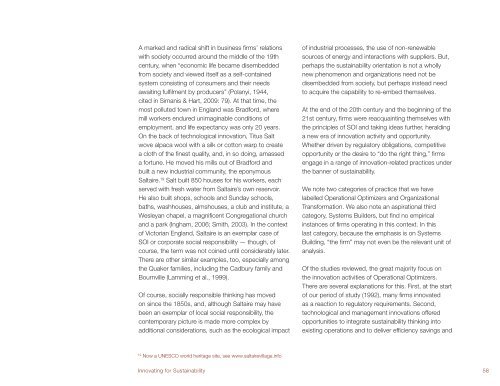Systematic Review - Network for Business Sustainability
Systematic Review - Network for Business Sustainability
Systematic Review - Network for Business Sustainability
You also want an ePaper? Increase the reach of your titles
YUMPU automatically turns print PDFs into web optimized ePapers that Google loves.
A marked and radical shift in business firms’ relations<br />
with society occurred around the middle of the 19th<br />
century, when “economic life became disembedded<br />
from society and viewed itself as a self-contained<br />
system consisting of consumers and their needs<br />
awaiting fulfilment by producers” (Polanyi, 1944,<br />
cited in Simanis & Hart, 2009: 79). At that time, the<br />
most polluted town in England was Brad<strong>for</strong>d, where<br />
mill workers endured unimaginable conditions of<br />
employment, and life expectancy was only 20 years.<br />
On the back of technological innovation, Titus Salt<br />
wove alpaca wool with a silk or cotton warp to create<br />
a cloth of the finest quality, and, in so doing, amassed<br />
a <strong>for</strong>tune. He moved his mills out of Brad<strong>for</strong>d and<br />
built a new industrial community, the eponymous<br />
Saltaire. 19 Salt built 850 houses <strong>for</strong> his workers, each<br />
served with fresh water from Saltaire’s own reservoir.<br />
He also built shops, schools and Sunday schools,<br />
baths, washhouses, almshouses, a club and institute, a<br />
Wesleyan chapel, a magnificent Congregational church<br />
and a park (Ingham, 2006; Smith, 2003). In the context<br />
of Victorian England, Saltaire is an exemplar case of<br />
SOI or corporate social responsibility — though, of<br />
course, the term was not coined until considerably later.<br />
There are other similar examples, too, especially among<br />
the Quaker families, including the Cadbury family and<br />
Bournville (Lamming et al., 1999).<br />
Of course, socially responsible thinking has moved<br />
on since the 1850s, and, although Saltaire may have<br />
been an exemplar of local social responsibility, the<br />
contemporary picture is made more complex by<br />
additional considerations, such as the ecological impact<br />
19 Now a UNESCO world heritage site, see www.saltairevillage.info<br />
of industrial processes, the use of non-renewable<br />
sources of energy and interactions with suppliers. But,<br />
perhaps the sustainability orientation is not a wholly<br />
new phenomenon and organizations need not be<br />
disembedded from society, but perhaps instead need<br />
to acquire the capability to re-embed themselves.<br />
At the end of the 20th century and the beginning of the<br />
21st century, firms were reacquainting themselves with<br />
the principles of SOI and taking ideas further, heralding<br />
a new era of innovation activity and opportunity.<br />
Whether driven by regulatory obligations, competitive<br />
opportunity or the desire to “do the right thing,” firms<br />
engage in a range of innovation-related practices under<br />
the banner of sustainability.<br />
We note two categories of practice that we have<br />
labelled Operational Optimizers and Organizational<br />
Trans<strong>for</strong>mation. We also note an aspirational third<br />
category, Systems Builders, but find no empirical<br />
instances of firms operating in this context. In this<br />
last category, because the emphasis is on Systems<br />
Building, “the firm” may not even be the relevant unit of<br />
analysis.<br />
Of the studies reviewed, the great majority focus on<br />
the innovation activities of Operational Optimizers.<br />
There are several explanations <strong>for</strong> this. First, at the start<br />
of our period of study (1992), many firms innovated<br />
as a reaction to regulatory requirements. Second,<br />
technological and management innovations offered<br />
opportunities to integrate sustainability thinking into<br />
existing operations and to deliver efficiency savings and<br />
Innovating <strong>for</strong> <strong>Sustainability</strong> 58
















